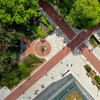Campus Plan
Temple and other universities typically initiate a comprehensive planning process about every 10 years. Visualize Temple, completed in 2014, led to transformational developments like the Charles Library and the Temple Sports Complex. More than 3,000 Temple community members gave their input and ideas for that plan, which presented seven planning goals grounded in Temple’s past, present and future. Much of Visualize Temple was implemented in some form or another.
A decade after Visualize Temple and in the wake of COVID-19, Temple is re-imagining its built environment once again, looking ahead to enrich students’ experiences, prepare students for the future of work, address demographic shifts in enrollment and support the enhancement of safety resources already underway. In addition to evolving university priorities, the overall landscape of higher education continues to change at a rapid pace. Universities need more flexible and agile spaces for learning, working and collaborating, as they empower students to meet the needs of employers and future economies.
Boundless Temple
A cutting-edge interactive map survey was enabled for the Temple community to illustrate how they experience campus day to day. Through this survey, listening sessions and other online feedback, the community can tell university planners about the changes they would like to see to the university’s built environment, which includes campus buildings, landscape architecture and roads. The goal of the campus development plan is to ensure that Temple’s built environment meaningfully contributes to the success of students, academic programs, faculty and staff, alumni, resources and services, learning spaces, and our community neighbors in the years and decades ahead. The plan will also look at how we can address current enrollment and safety issues and identify opportunities for innovation.
In partnership with Sasaki Associates, a world-renowned architecture and planning firm, the survey will capture thousands of voices to inform the look and feel of Temple’s classrooms, housing, outdoor spaces and much more. Participants have the opportunity to rate and leave comments about the physical attributes of their favorite places to eat and study, or areas that they feel are unwelcoming. Gathering community input is the first step of the planning initiative, which will result in recommendations for future development.
Since fall 2022, Temple’s Project Delivery Group—which is responsible for the university’s planning, design and construction—has been working with the Boundless Temple Steering Committee—which comprises wide-ranging constituents from across the university—to identify the plan phases and objectives. Temple’s campus development plan will take all of these factors into consideration to help students thrive and position the university for future success.

